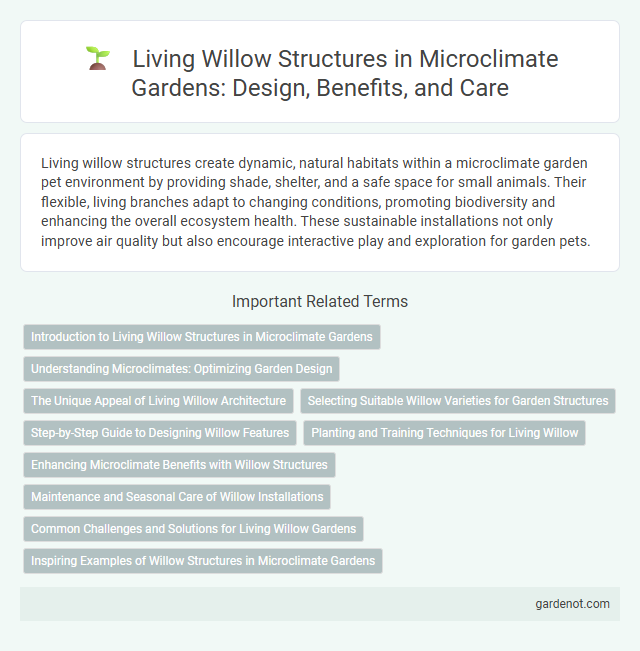Living willow structures create dynamic, natural habitats within a microclimate garden pet environment by providing shade, shelter, and a safe space for small animals. Their flexible, living branches adapt to changing conditions, promoting biodiversity and enhancing the overall ecosystem health. These sustainable installations not only improve air quality but also encourage interactive play and exploration for garden pets.
Introduction to Living Willow Structures in Microclimate Gardens
Living willow structures in microclimate gardens serve as dynamic, eco-friendly elements that enhance local biodiversity and regulate temperature and humidity. These green frameworks, grown from pliable willow branches, create natural shelters and windbreaks, improving microclimatic conditions for surrounding plants. The porous nature of living willow enables effective air circulation while providing habitat for beneficial insects, promoting a balanced and resilient garden ecosystem.
Understanding Microclimates: Optimizing Garden Design
Living willow structures create unique microclimates by providing natural windbreaks and shade that regulate temperature and moisture levels within a garden space. These dynamic, adaptable forms increase humidity and protect delicate plants from harsh conditions, enhancing biodiversity and plant health. Utilizing living willow enhances garden design by fostering microhabitats tailored to specific plant needs, improving growth and resilience.
The Unique Appeal of Living Willow Architecture
Living willow architecture offers a sustainable and eco-friendly solution for microclimate gardens by creating natural, breathable structures that enhance air quality and provide habitat for local wildlife. The flexibility and rapid growth of living willow allow for customizable shapes and sizes, promoting biodiversity while blending seamlessly with the natural environment. These green structures also contribute to temperature regulation and moisture retention, improving the overall microclimate and garden health.
Selecting Suitable Willow Varieties for Garden Structures
Choosing suitable willow varieties for living willow structures involves prioritizing species with flexible yet sturdy stems, such as Salix viminalis and Salix alba, known for rapid growth and durability. These varieties adapt well to diverse soil conditions and provide resilience against seasonal weather variations, ensuring long-lasting garden architecture. Proper selection enhances the microclimate benefits by promoting natural cooling and biodiversity within the garden space.
Step-by-Step Guide to Designing Willow Features
Creating a living willow structure begins with selecting flexible willow rods during early spring when the sap is rising for easy bending. Secure the rods vertically in moist soil, spacing them evenly to form the desired shape, and weave horizontal rods through these stakes to provide stability and design complexity. Regular pruning and moisture maintenance are essential to encourage growth and maintain the integrity of the willow feature within the microclimate garden.
Planting and Training Techniques for Living Willow
Living willow structures thrive through careful planting by selecting healthy, flexible willow rods planted densely in well-drained soil to encourage rapid root development. Training techniques involve weaving the young shoots while they are pliable, bending them into desired shapes, and securing connections using natural ties to create stable, living frameworks. Regular pruning during growth seasons promotes dense foliage and robust structural integrity, essential for durable and aesthetically pleasing microclimate garden installations.
Enhancing Microclimate Benefits with Willow Structures
Living willow structures improve microclimate conditions by increasing humidity and providing natural shade, which helps regulate temperature and reduce wind speed. These eco-friendly installations promote biodiversity by creating habitats for insects and birds, contributing to a balanced ecosystem. The flexible growth of willow branches allows for customized designs that optimize light diffusion and air circulation in garden spaces.
Maintenance and Seasonal Care of Willow Installations
Living willow structures require regular pruning to maintain their shape and encourage healthy growth, especially during early spring and late autumn. Seasonal care involves monitoring moisture levels, as willows thrive in damp conditions but may suffer in prolonged droughts, necessitating supplemental watering. Periodic inspection for pest infestations and timely removal of dead or damaged branches ensure the structural integrity and longevity of willow installations in microclimate gardens.
Common Challenges and Solutions for Living Willow Gardens
Living willow structures in microclimate gardens often face challenges such as slow initial growth and seasonal dieback, which can hinder their structural integrity. Proper selection of willow species like Salix viminalis, timely planting during dormant seasons, and consistent watering help promote rapid establishment and resilience. Training young shoots regularly and using support frameworks minimize breakage and maintain the desired shape throughout varying weather conditions.
Inspiring Examples of Willow Structures in Microclimate Gardens
Living willow structures in microclimate gardens create dynamic, natural shelters that adapt to environmental conditions, enhancing biodiversity and promoting micro-ecosystems. Notable examples include willow domes, arbors, and tunnels that provide shade, regulate temperature, and foster moisture retention, essential for sustaining diverse plant and animal life. These green frameworks combine functional design with ecological benefits, making them a vital component of sustainable garden practices.
Living willow structure Infographic

 gardenot.com
gardenot.com